

 Python Tutorials Python Tutorials | (back to the list of tutorials) |
 Offset Curves
Offset Curves![]()
![]()
![]()
![]()
add_library('igeo')
size(480, 360, IG.GL)
cpts1 = [ IVec(-60,0,0),IVec(-40,0,0),IVec(-40,20,0),IVec(-60,20,0)]
curve1 = ICurve(cpts1).clr(0)
IG.offset(curve1, 5.0).clr(1.0,0,0)
cpts2 = [ IVec(-20,0,0), IVec(-10,20,0), IVec(-10,0,0) ]
curve2 = ICurve(cpts2, True).clr(0)
IG.offset(curve2, 5).clr(1.0,0,0)
cpts3 = [ IVec(10,0,0),IVec(20,20,0),IVec(20,0,0) ]
curve3 = ICurve(cpts3, 2).clr(0)
IG.offset(curve3, 5).clr(1.,0,0)
cpts4 = [ IVec(40,0,0),IVec(50,20,0),IVec(50,0,0) ]
curve4 = ICurve(cpts4, 2, True).clr(0)
IG.offset(curve4, 5).clr(1.,0,0)
cpts5 = [ IVec(-20,60,0),IVec(10,60,0),IVec(10,60,20) ]
curve5 = ICurve(cpts5, True).clr(0)
IG.offset(curve5, 5).clr(1.,0,0)
cpts6 = [ IVec(80,0,0),IVec(90,0,20),IVec(100,0,20),IVec(100,20,20),IVec(80,20,0) ]
curve6 = ICurve(cpts6, True).clr(0)
IG.offset(curve6, 5).clr(1.,0,0)
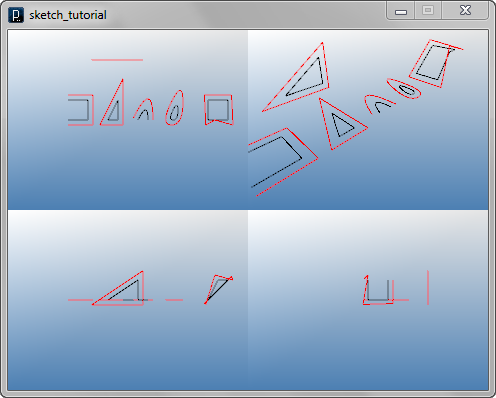
The offset distance of degree 1 curve can have
constant distance between the original curve (polyline) and
the offset one, like the curve1 and curve2 in
the code above.
However, if the curve's degree is more than 2 and
curving, the distance between two curve is not constant,
like curve3 and curve4 on the code,
because it's simply taking offset vertices of a degree 1 curve
as its control points.
If an input curve is not planar curve,
offset curve is deformed accordingly and also non-planar, like
the curve6 on the code.
 Lofting
Lofting![]()
![]()
![]()
![]()
add_library('igeo')
size(480, 360, IG.GL)
cpts1 = [ IVec(-50,0,0),IVec(-30,0,0),IVec(-30,-20,0),IVec(-50,-20,0) ]
curve1 = ICurve(cpts1).clr(1.,0,1.)
cpts2 = [ IVec(-40,20,30),IVec(-30,20,30),IVec(-30,0,30),IVec(-40,0,30) ]
curve2 = ICurve(cpts2).clr(1.,0,1.)
# loft of two curves
IG.loft(curve1, curve2).clr(0.2)
cpts3 = [ IVec(-20,0,0),IVec(10,0,0),IVec(10,-20,0),IVec(-20,-20,0) ]
curve3 = ICurve(cpts3,3,True).clr(1.,1.,0)
cpts4 = [ IVec(-10,0,20),IVec(0,0,20),IVec(0,-20,20),IVec(-10,-20,20) ]
curve4 = ICurve(cpts4,3,True).clr(1.,1.,0)
cpts5 = [ IVec(-20,20,40),IVec(10,20,40),IVec(10,-20,40),IVec(-20,-20,40) ]
curve5 = ICurve(cpts5,3,True).clr(1.,1.,0)
# loft of multiple curves in an array (degre=1, straight)
IG.loft([ curve3, curve4, curve5 ]).clr(0.2)
curve6 = curve3.dup().mv(40,0,0).clr(0,1.,1)
curve7 = curve4.dup().mv(40,0,0).clr(0,1.,1)
curve8 = curve5.dup().mv(40,0,0).clr(0,1.,1)
# degree 2 curved lofting
IG.loft([ curve6, curve7, curve8 ], 2 ).clr(0.2)

 Extruding Point Array
Extruding Point Array![]()
![]()
![]()
![]()
add_library('igeo')
size(480, 360, IG.GL)
pts1 = [ IVec(-50,-20,0),IVec(-30,-20,0),IVec(-30,0,0),IVec(-50,0,0) ]
# extrude points to their normal direction
IG.extrude(pts1, 30).clr(0.2)
pts2= [ IVec(-20,0,0),IVec(10,0,0),IVec(10,-20,0),IVec(-20,-20,0) ]
# extrude degree 2 closed profile
IG.extrude(pts2, 2, True, -20).clr(0.2)
pts3= [ IVec(20,0,0),IVec(50,0,0),IVec(50,-20,0),IVec(20,-20,0) ]
# extrude in the direction specified by a vector
IG.extrude(pts3, 1, True, IVec(10,20,30)).clr(0.2)
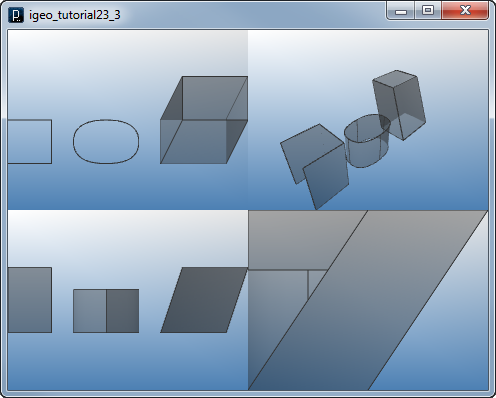
 Extruding Curves
Extruding Curves![]()
![]()
![]()
![]()
add_library('igeo')
size(480, 360, IG.GL)
pts1 = [ IVec(-50,-20,0),IVec(-30,-20,0),IVec(-30,0,0),IVec(-50,0,0) ]
curve1 = ICurve(pts1).clr(1.,0,1.)
IG.extrude(curve1, 30).clr(0.2)
pts2 = [ IVec(-20,0,0),IVec(10,0,0),IVec(10,-20,0),IVec(-20,-20,0) ]
curve2 = ICurve(pts2, 2, True).clr(1.,1.,0)
IG.extrude(curve2, -20).clr(0.2)
pts3 = [ IVec(20,0,0),IVec(50,0,0),IVec(50,-20,0),IVec(20,-20,0) ]
curve3 = ICurve(pts3, 1, True).clr(0,1.,1.)
IG.extrude(curve3, IVec(10,20,30)).clr(0.2)

 Sweeping Point Arrays
Sweeping Point Arrays![]()
![]()
![]()
![]()
add_library('igeo')
size(480, 360, IG.GL)
profile1 = [ IVec(5,0,0),IVec(5,5,0),IVec(0,5,0) ]
rail1 = [ IVec(-40,0,-20),IVec(-30,0,10),IVec(-50,0,20) ]
# sweeping open profile and open rail
IG.sweep(profile1, rail1).clr(0.2)
profile2 = [ IVec(0,0,0),IVec(10,0,0),IVec(10,10,0),IVec(0,10,0) ]
rail2 = [ IVec(0,20,-20),IVec(0,0,20),IVec(0,-20,-20) ]
# sweeping degree 2 closed profile and degree 2 open rail
IG.sweep(profile2, 3, True, rail2, 2, False).clr(0.5,0,0)
profile3 = [ IVec(-5,0,0),IVec(0,5,0),IVec(0,-5,0) ]
rail3 = [ IVec(40,20,-20),IVec(40,0,20),IVec(40,-20,-20) ]
# sweeping degree 2 closed profile and degree 2 open rail
IG.sweep(profile3, 1, True, rail3, 1, True).clr(0,0,0.5)

 Sweeping Curves
Sweeping Curves![]()
![]()
![]()
![]()
add_library('igeo')
size(480, 360, IG.GL)
profile1 = [ IVec(0,0,0),IVec(10,0,0),IVec(10,10,0),IVec(0,10,0) ]
profileCrv1 = ICurve(profile1,3).clr(0,1.,1.)
rail1 = [ IVec(-50,0,-30),IVec(-30,0,0),IVec(-30,0,30) ]
railCrv1 = ICurve(rail1).clr(1.,1.,0)
# sweeping open profile and open rail
IG.sweep(profileCrv1, railCrv1).clr(0.2)
# ellipse profile
profileCrv2 = ICircle(0,0,0,10,5).clr(0,1.,1.)
rail2 = [ IVec(0,20,-20),IVec(0,0,20),IVec(0,-20,-20) ]
railCrv2 = ICurve(rail2, 2).clr(1.,1.,0)
# sweeping degree 2 closed profile and degree 2 open rail
IG.sweep(profileCrv2, railCrv2).clr(0.5,0,0)
profile3 = [ IVec(-5,0,0),IVec(0,5,0),IVec(0,-5,0) ]
profileCrv3 = ICurve(profile3,True).clr(0,1.,1.)
# circle profile
railCrv3 = ICircle(IVec(40,0,0),IVec(1,0,0),30).clr(1.,1.,0)
# sweeping degree 2 closed profile and degree 2 open rail
IG.sweep(profileCrv3, railCrv3).clr(0,0,0.5)
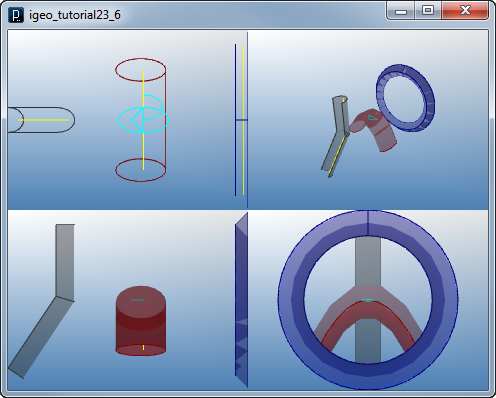
 Circular Pipe Along Curves
Circular Pipe Along Curves![]()
![]()
![]()
![]()
add_library('igeo')
size(480, 360, IG.GL)
curve1 = ICurve(IVec(-40,0,-20),IVec(-30,20,30))
IG.pipe(curve1, 2).clr(.2)
curve2 = ICurve([ IVec(-10,0,-30),IVec(-10,-10,-10),IVec(-10,10,10),IVec(-10,0,30) ])
IG.pipe(curve2,6).clr(0.5,0,0)
curve3 = ICircle(IVec(20,0,0),IVec(1,0,0),20)
IG.pipe(curve3,4).clr(1.0,0,0.5)
curve4 = ICurve([ IVec(50, -20, 20),IVec(40, 30, 0),IVec(70, 0, 40), \
IVec(50, -10, -10),IVec(60, -40, -10) ], \
2, True)
IG.pipe(curve4, 4).clr(0,0,0.8)
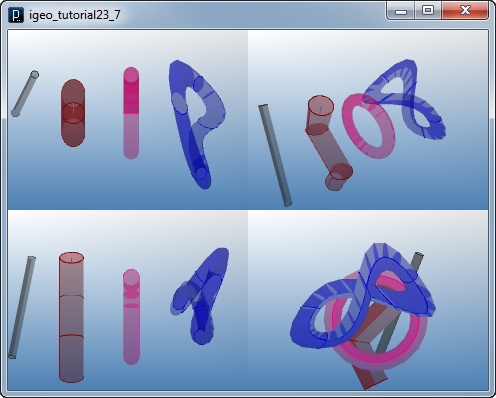
 Rectangular Pipe Along Curves
Rectangular Pipe Along CurvesIn the same way with creating circular pipes, you can also create rectangular or square pipes with IG.rectPipe(ICurve,double,double) or IG.squarePipe(ICurve,double).
![]()
![]()
![]()
![]()
add_library('igeo')
size(480, 360, IG.GL)
curve1 = ICurve(IVec(-40,0,-20),IVec(-30,20,30))
IG.rectPipe(curve1, 10,2).clr(.2)
curve2 = ICurve([ IVec(-10,0,-30),IVec(-10,-10,-10),IVec(-10,10,10),IVec(-10,0,30) ])
IG.rectPipe(curve2,5,10).clr(0.5,0,0)
curve3 = ICircle(IVec(20,0,0),IVec(1,0,0),20)
IG.squarePipe(curve3,8).clr(1.0,0,0.5)
curve4 = ICurve([ IVec(50, -20, 20),IVec(40, 30, 0),IVec(70, 0, 40), \
IVec(50, -10, -10),IVec(60, -40, -10) ], \
2, True)
IG.squarePipe(curve4,8).clr(0,0,0.8)
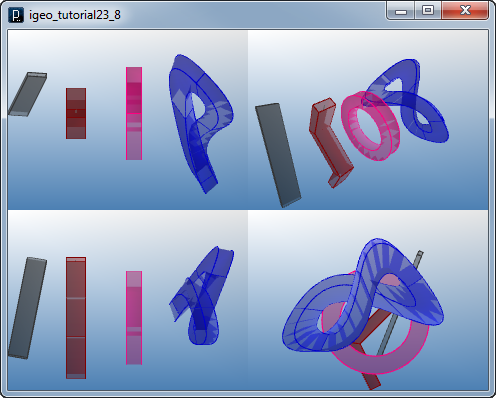
 HOME
HOME
 FOR PROCESSING
FOR PROCESSING
 DOWNLOAD
DOWNLOAD
 DOCUMENTS
DOCUMENTS
 TUTORIALS (Java /
Python)
TUTORIALS (Java /
Python)
 GALLERY
GALLERY
 SOURCE CODE(GitHub)
SOURCE CODE(GitHub)
 PRIVACY POLICY
PRIVACY POLICY
 ABOUT/CONTACT
ABOUT/CONTACT
